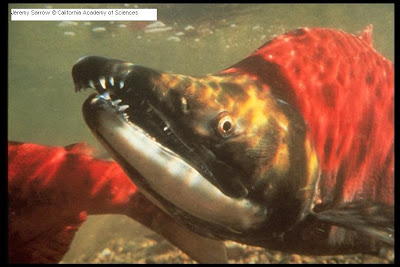When breeding time approaches, the ocean-living salmon return to their lake of birth, following their nose and the sun. Once they hit fresh water, their scales turn red and the males grow some gnarly fangs (see below).
I, for one, am really, really glad that I don't have to turn red, grow fangs, and return to my birth hospital to spawn. My wife would have a hard time with that.
Photo credit: Jeremy Sarrow © California Academy of Sciences


And they die after spawning. Your wife *really* wouldn't like that!
ReplyDeleteThat's a Pink Salmon, not a sockeye, while sockeye do change colour as they migrate up fresh water rivers, they don't get the hump back and hooked nose that Pink salmon do.
ReplyDeleteAnonymous--alas, both species do get those features as they migrate...I double-checked to make sure. Here's both Wikipedia pages on them:
ReplyDeletehttp://en.wikipedia.org/wiki/Sockeye_salmon
http://en.wikipedia.org/wiki/Pink_salmon
The Pink gets an even more pronounced hump on their back than the Sockeye, but it looks like the Sockeye gets that distinct bright red on its flanks like the fish in the picture has. And both get those manky-lookig hooked jaws that the lady-fish find so irresistable...
Maybe it's a crossbreed? I wonder what it'd taste like...? ;-)
--TwoDragons
Actually, to be really nit-picky... as I'm from Canada and see this event every year:
ReplyDeleteThe salmon don't 'change' colour. What you're seeing is the fishes's flesh. Because they don't eat, sleep or rest until they've spawned, their bodies begin to digest themselves, beginning with the scales. Hence, you see here, the revealed salmon flesh.
I bet your wife would *really* love that.
"Dear, you're getting muscular ooze all over the good sheets."